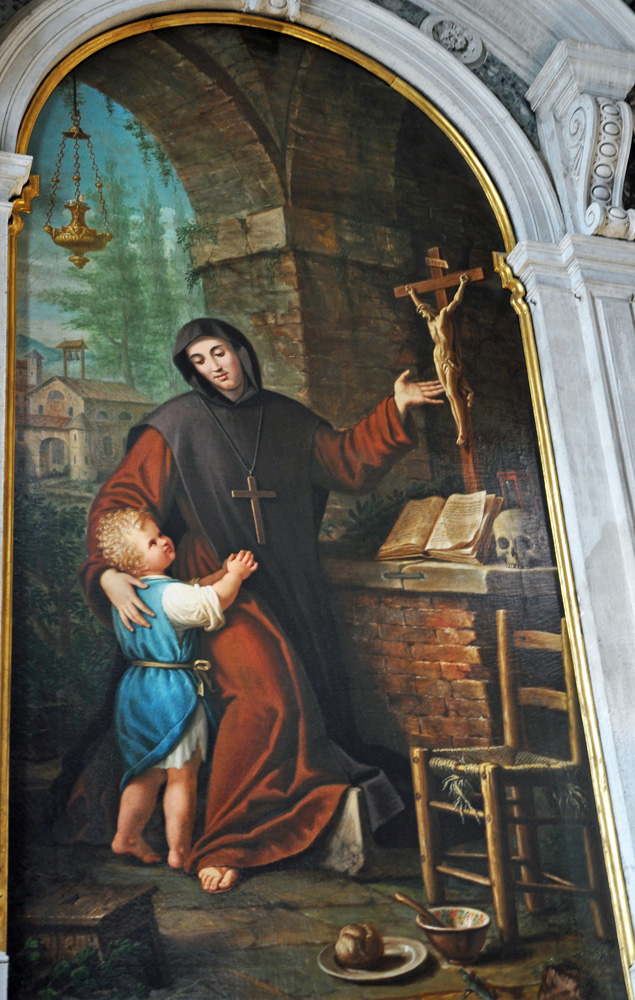The story
In a 6th-century vita of this saint a layman decides to enter the monastic life. He dresses his little daughter Marina as a boy, goes to a monastery, and asks that the two of them be accepted. As the years go by, "Marinus" develops into a valued member of the community, but no one suspects she is not a man.One day the abbot sends "Marinus" on monastery business to a distant seaport, where she stays the night in a tavern and returns the following day. After some months, the tavernkeeper's daughter, visibly pregnant, comes to the monastery and names "Marinus" as the father. At this point the reader might imagine that Marina would defend herself by revealing that she is a woman, as St. Eugenia does in the same situation in another well-known vita.1 But instead Marina simply tells the abbot, "I have sinned, Father, I am doing penance for this sin, pray for me." The abbot naturally takes "this sin" to be the one alleged by the innkeeper's daughter, but the reader sees that Marina is accepting this unearned obloquy for other sins, presumably much less grave. She is expelled from the monastery and lives at its gate for three years, sustained only by an occasional morsel of bread given by the monks.
After the three years the innkeeper's wife arrives with the child in tow, a boy. She demands, and the abbot agrees, that "Marinus" should be responsible for the boy, so Marina keeps him with her at the gate, sharing those bits of bread for two years until the abbot relents and lets her return to the monastery as a servant assigned the vilest chores. She guards the secret of her sex until she dies, at which point the monks realize she was a woman and incapable of the sin for which she lived in shame all those years.
Over the years many writers adapted this story in various ways. The version in Caxton's translation of the Golden Legend uses a descendent of the 6th-century vita with only slight variations, not the chapter on Marina in the Golden Legend itself, which is much abridged.
The Images
Portraits usually have St. Marina in something like a monastic habit with a small child and a crucifix (example). The narrative image in the first picture at right sentimentalizes the plight of Marina and the boy. Instead of begging bread at the gate of the monastery they are in a cozy domestic setting where Marina teaches the boy religion. This softening of the saint's plight may be due to the painting's location. Beneath it the saint's body lies in a glass case, in Santa Maria Formosa, Venice. The body was translated there from Lebanon in 1231.More Marinas
Besides our St. Marina, sometimes called "Marina of Alexandria," another saint named Marina is recorded in the Roman Martyrology for July 18: Gallaeciae, in Hispania, sanctae Marinae, Virginis et Martyris. ("In Galicia, Spain, [the natal day of] St. Marina, Virgin and Martyr"). Also, St. Margaret of Antioch is called Marina in some Greek sources. Unlike our Marina, both these saints were martyrs.2
Prepared in 2019 by Richard Stracke, Emeritus Professor of English, Augusta University.
HOME PAGE

St. Marina teaching her child about the crucifix. (See the description page.)
ATTRIBUTES
- Small child
- Crucifix
MORE IMAGES
- 14th century: In a miniature from a manuscript of the Golden Legend Marina is told to take the child and leave the monastery.
- Not dated: A portrait in the Accademia Gallery, Venice.
DATES
- July 17 is observed in Maronite The Maronites are the Lebanese branch of Roman Catholicism, with their own liturgy and hierarchy. churches as St. Marina's feast day and in the Roman Martyrology as the day of her translation.
- The Golden Legend says she died on June 19.
BIOGRAPHY
- Golden Legend #84
- The 6th-century Vita Sanctae Marinae Virginis, of unknown authorship, is in the Vitae Patrum, Migne, Pat. Lat., LXXIII, 691-96, and at this page at Wikifons (as of 2023-04-20).
- John the Stylites's 8th-century vita in Syriac is in Select Narratives, 36-45.
NOTES
1 See "St. Eugenia: The Iconography".
2 Rosweyde untangles the vitae of the three saints: Migne, Pat. Lat. LXXIII, 693, note 1.